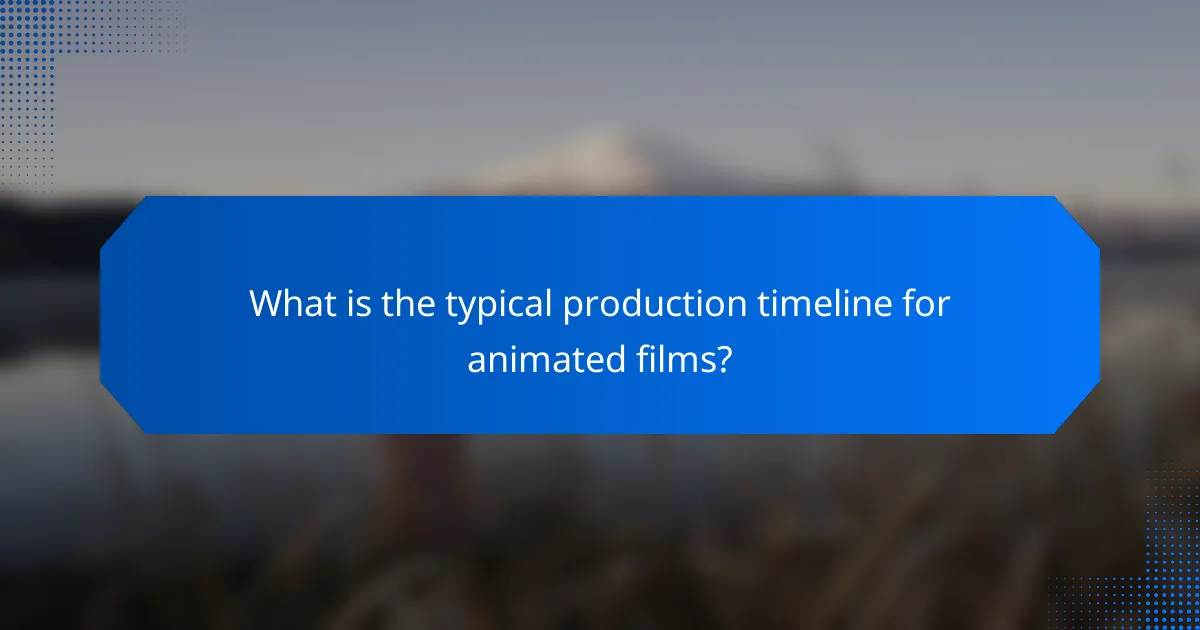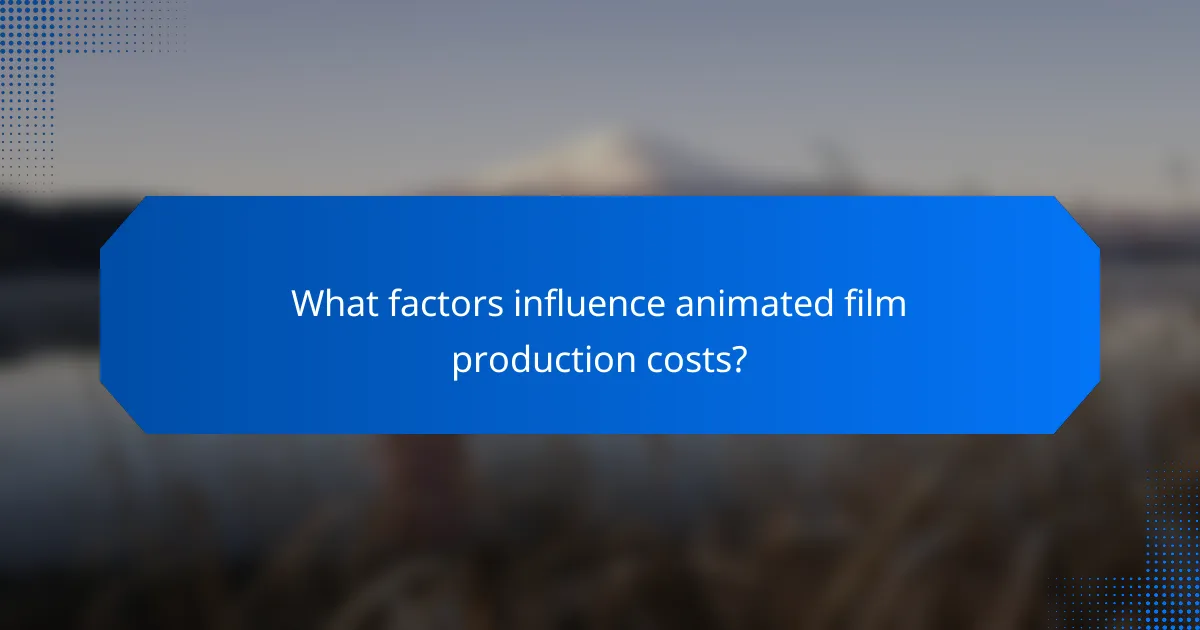Creating an animated film involves various costs, including software expenses that can range from free tools to thousands of dollars for professional-grade applications. Salaries for artists in the industry also fluctuate widely, with entry-level positions earning less than seasoned professionals. The entire production timeline can extend from several months to a few years, encompassing critical phases such as pre-production, production, and post-production, each with its own set of tasks and timelines.

What are the costs of animated film software in Canada?
The costs of animated film software in Canada can vary significantly based on the type of software and its licensing model. Generally, prices range from free options to several thousand Canadian dollars for industry-standard tools.
Industry-standard software pricing
Industry-standard animation software typically falls within a price range of CAD 500 to CAD 3,000. Popular tools like Autodesk Maya and Adobe After Effects are often on the higher end of this spectrum. These prices reflect the comprehensive features and capabilities required for professional animation production.
Free vs. paid software options
Free animation software, such as Blender and Pencil2D, offers robust features suitable for beginners and independent creators. However, paid software often provides advanced tools, customer support, and regular updates that can enhance productivity and quality. Weighing the benefits of each option is crucial depending on the project’s scope and budget.
Subscription models for animation software
Many animation software providers now offer subscription models, allowing users to pay monthly or annually. For instance, Adobe Creative Cloud offers access to multiple applications for around CAD 60 per month. Subscription models can be cost-effective for studios that require flexibility and the latest features without a significant upfront investment.

What are the average salaries for animated film artists in Canada?
The average salaries for animated film artists in Canada vary significantly based on experience and skill level. Entry-level positions typically start lower, while senior roles command much higher compensation, reflecting the artist’s expertise and contributions to projects.
Entry-level artist salaries
Common roles at this level include junior animators and storyboard artists. Entry-level artists should focus on building their skills and networking within the industry to advance their careers.
Mid-level artist salaries
Mid-level animated film artists in Canada typically earn between CAD 55,000 and CAD 80,000 per year. These artists usually have several years of experience and may take on more complex tasks such as character design or animation direction.
To succeed at this level, artists should continue to refine their craft and may benefit from specializing in certain animation techniques or software. Building a strong professional network can also lead to better job opportunities.
Senior artist salaries
Senior animated film artists in Canada can earn upwards of CAD 80,000, with some positions exceeding CAD 100,000 annually. These roles often involve leadership responsibilities, such as overseeing teams or managing projects.
Senior artists are expected to have extensive experience and a robust portfolio. They should also stay updated on industry trends and technologies to maintain their competitive edge in the field.

What is the typical production timeline for animated films?
The production timeline for animated films generally spans from several months to a few years, depending on the complexity and scale of the project. Key phases include pre-production, production, and post-production, each with distinct tasks and timelines that contribute to the overall schedule.
Pre-production phases
Pre-production is the planning stage where the concept is developed, scripts are written, and storyboards are created. This phase typically lasts several months and involves assembling a team, designing characters, and establishing the visual style. It’s crucial to finalize the budget and schedule during this time to avoid delays later.
Common tasks include casting voice actors, creating animatics, and developing a production pipeline. A well-structured pre-production can significantly streamline the subsequent phases, ensuring that everyone is aligned on the project’s vision.
Production phases
The production phase is where the actual animation takes place, often lasting from several months to over a year. This phase involves animating scenes, recording voiceovers, and integrating sound effects and music. Depending on the animation style—such as 2D, 3D, or stop-motion—the timeline can vary widely.
During production, it’s essential to maintain clear communication among team members to address any issues promptly. Regular reviews and adjustments can help keep the project on track and within budget.
Post-production phases
Post-production is the final stage, focusing on editing, visual effects, and sound design. This phase can take a few months and is critical for polishing the film before its release. Tasks include color correction, finalizing the soundtrack, and adding credits.
It’s important to allocate sufficient time for post-production to ensure the film meets quality standards. Delays in this phase can impact release dates, so planning ahead is vital for a successful launch.

What factors influence animated film production costs?
Animated film production costs are influenced by various factors including team size, animation style, and the technology used. Understanding these elements can help in budgeting and planning for a successful project.
Team size and expertise
The size and expertise of the team directly impact production costs. A larger team with specialized skills, such as character animators, background artists, and technical directors, can increase expenses significantly. For instance, a small team might manage a project for tens of thousands of USD, while a larger, more experienced team could push costs into the hundreds of thousands or more.
Hiring experienced professionals often leads to higher salaries but can improve the quality and efficiency of the production. Balancing team size with skill level is crucial; a well-rounded team can often achieve better results than a larger, less experienced group.
Animation style and complexity
The chosen animation style and its complexity greatly affect production costs. Traditional hand-drawn animation typically requires more labor and time compared to 3D animation, which can utilize software to streamline processes. For example, a feature-length 2D animated film may take several years and substantial resources, while a 3D project could be completed in a shorter timeframe with the right tools.
Complexity also plays a role; intricate designs and detailed backgrounds require more work, increasing costs. Producers should evaluate the desired style against budget constraints to ensure feasibility.
Technology and tools used
The technology and tools employed in animation can significantly influence production costs. High-end software licenses, such as those for Maya or Blender, can be expensive, while open-source options may reduce costs but require more time for artists to master. Budgeting for software and hardware is essential, as it can range from a few hundred to several thousand USD depending on the tools selected.
Investing in the latest technology can enhance productivity and quality, but it’s important to balance these costs with the overall budget. Regularly assessing the tools and technologies can help identify opportunities for cost savings without sacrificing quality.

How do Canadian animated films compare to international productions?
Canadian animated films often have lower production costs and unique artistic styles compared to international counterparts. While they may not always match the budgets of major studios in the U.S. or Europe, they frequently emphasize creativity and storytelling that resonate with diverse audiences.
Budget differences
Canadian animated films typically operate on budgets that can range from hundreds of thousands to a few million Canadian dollars, significantly lower than the tens of millions often seen in major international productions. This cost-effectiveness allows for innovative approaches, although it may limit the scale of projects.
In Canada, government funding and tax incentives further reduce costs, making animation more accessible for smaller studios. This financial support can lead to a vibrant indie scene, where unique stories and styles thrive without the pressure of blockbuster expectations.
Quality and style variations
The quality of Canadian animated films can vary widely, but many are recognized for their distinct artistic styles and storytelling. Canadian productions often prioritize character-driven narratives and cultural themes, which can differ from the more commercial focus of larger international studios.
For example, films like “The Breadwinner” showcase a blend of traditional animation techniques with contemporary storytelling, reflecting both local culture and universal themes. This artistic diversity can appeal to niche markets and audiences looking for fresh perspectives.
Market reach and distribution
Canadian animated films generally have a more limited market reach compared to major international productions, which benefit from extensive global distribution networks. However, Canadian films often find success in film festivals and niche platforms, gaining recognition for their unique content.
To enhance distribution, Canadian studios may collaborate with international partners or utilize streaming services, which have become increasingly important for reaching wider audiences. This strategy allows them to capitalize on their unique storytelling while navigating the competitive global market.

What are the emerging trends in animated film production?
Emerging trends in animated film production include the integration of advanced technologies like AI, virtual reality (VR), and augmented reality (AR), as well as a growing focus on diverse storytelling. These trends are reshaping how animated films are created and experienced, offering new opportunities for creativity and audience engagement.
Use of AI in animation
The use of AI in animation is revolutionizing the production process by automating repetitive tasks and enhancing creativity. AI tools can assist in generating character animations, creating backgrounds, and even suggesting storylines, which can significantly reduce production time and costs.
For instance, AI-driven software can analyze existing animations to create new styles or mimic specific artistic techniques, allowing studios to produce high-quality content more efficiently. However, it’s essential to balance AI usage with human creativity to maintain the unique artistic vision of a project.
Virtual reality and augmented reality integration
Virtual reality (VR) and augmented reality (AR) are becoming increasingly prominent in animated films, providing immersive experiences that engage audiences in novel ways. These technologies allow viewers to interact with animated worlds and characters, enhancing storytelling by making it more participatory.
Studios are experimenting with VR and AR to create experiences that extend beyond traditional viewing, such as interactive short films or augmented scenes that viewers can explore through their devices. This integration requires careful planning and investment, but it can lead to innovative storytelling opportunities and increased audience engagement.
Shift towards diverse storytelling
There is a notable shift towards diverse storytelling in animated films, reflecting a broader range of cultures, experiences, and perspectives. This trend is driven by both audience demand for representation and the recognition that diverse narratives can lead to richer, more relatable content.
Studios are increasingly prioritizing stories that feature underrepresented voices and themes, which can resonate with a wider audience. This shift not only enriches the animation landscape but also encourages collaboration among diverse talent, fostering creativity and innovation in the industry.

